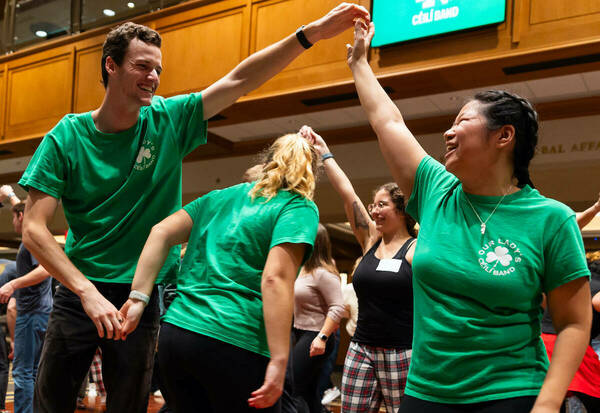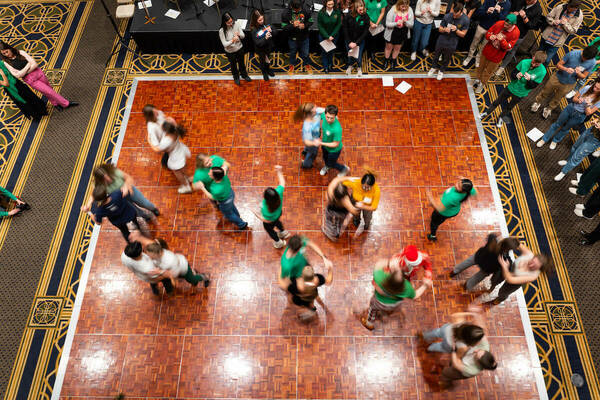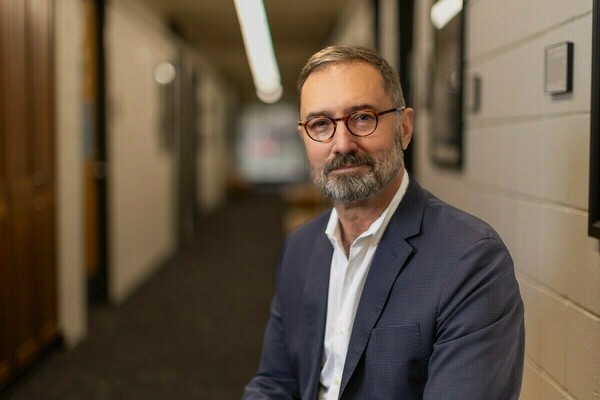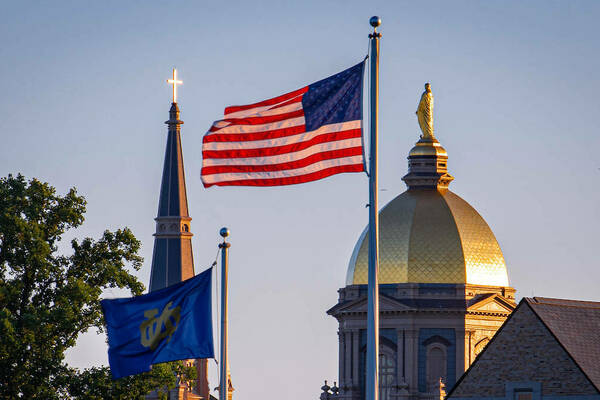
While some may not know the meaning of the Irish words ceol, rince, and craic on posters that promote a céilí, previous attendees of the campus Irish social know well that they mean music, dance, and fun.
And, at a recent céilí [KAY-lee] in Corbett Family Hall’s Downes Club ballroom, more than 200 Notre Dame students and community members flocked to experience all of that. And more.
Sophomore biology major Jaidin Esser said she feels “unparalleled joy” at céilís, where, in addition to camaraderie and spontaneous laughter, there are opportunities to learn about culture and language.
That’s the goal for Shannon Dunne ’98. After graduating from Notre Dame, she traveled frequently to the remote villages on the Emerald Isle to learn traditional music and sean-nós [old-style] dancing from tradition-bearers.
She was inspired to do so after experiencing the music and dance culture in Connemara. The old way of dancing, in particular, grabbed her attention. Watching dancers of all ages and abilities jump up and add rhythm to the music, Dunne thought, “This is what I do. This is what I’m supposed to be doing.”
Now, it’s what she does.
In addition to her duties as an adjunct assistant teaching professor in the Department of Irish Language and Literature, Dunne is a tradition bearer, educator, and community builder.
She also has devised a three-credit Irish music and dance course at Holy Cross College, and founded the Irish Music program with the Moreau College Initiative, a college-in-prison program at Westville Correctional Facility, in which participants can study music courses, or play socially in weekly Irish sessions, on whistle, banjo, fiddle, concertina, bodhrán, and guitar.
At the winter social, the Notre Dame Céilí Band of students, faculty, and staff — whose abilities range from beginner to expert — played songs like “Shoe the Donkey,” “Walls of Limerick,” and “Siege of Ennis” on concertinas, banjos, fiddles, flutes, tin whistles, bodhrán, electric organ, and harp.
A dozen or so dance partners, some sporting green T-shirts and jeans and others wearing dresses, fit on the parquet floor. Dozens more spilled onto the carpet in the seventh-floor space in Corbett Family Hall.
Dunne organized the first Irish dance social in 2021 soon after she started teaching one-credit courses — Sean-nós Dancing and Beginning Tin Whistle. The two courses proved so popular that two more were added: Irish Dance and Notre Dame Céilí Band.
“The exponential growth is bananas,” she said. “This is casual and fun and students are connecting with Irish culture in meaningful ways and deepening a connection with each other.”
That resonates with junior neuroscience and behavior major Bridget Hayes. She added a minor in Irish studies because her involvement with the band and céilís piqued her interest in Irish customs and history.
Senior Kylee Kazenski, who last fall became the first woman to portray the leprechaun at a Notre Dame football game, also loves the offerings. She plays tin whistle and banjo, takes part in sean-nós dancing, and is a member of the ND Céilí Band.
“I was hooked from my first Irish dance class that a friend urged me to take,” said Kazenski, a computer science major. “I embraced Irish music and dance as a part of my everyday life and even brought some sean-nós steps to the leprechaun role.”
Kazenski was one of the students who traveled with Dunne last summer to Ireland.
During the nearly two-week immersive trip, Kazenski and peers experienced various settings and manner in which traditional music is used to socialize, inspire, and teach.
For instance, they visited Galway, where live Irish folk music flourishes in pubs; Glin, to meet master fiddler Brendan Mulvihill; Inisheer, to experience an island that 260 people call home; Mullingar, the site of a traditional Irish music celebration; and Kilfenora, to learn from Ireland’s oldest céilí band.
“The students then met as a group to talk about how best to use traditional music to enhance the unique Notre Dame experience, for tourists, students, and community,” Dunne said.

Because of classes, céilís, and the trip to Ireland, students have become interested in competitions. Dunne is coaching three sets of dancers and one solo dancer from Notre Dame to participate at the Midwest Fleadh Cheoil (Festival of Music) on April 26-28 in Chicago, in hopes of qualifying for Fleadh Cheoil na hÉireann (Music Festival of Ireland) in August in Ireland.
Next up for the Notre Dame Céilí Band is the Department of Irish Language and Literature Céilí from 8-10 p.m. Wednesday, May 1, in the Corbett ballroom.
“In only a couple of years, Shannon has brought about a transformation in the existence of Irish culture at Notre Dame,” said Aedín Clements, who recently retired as Irish studies librarian at Hesburgh Libraries. “And I hope this will continue to grow and develop.”


